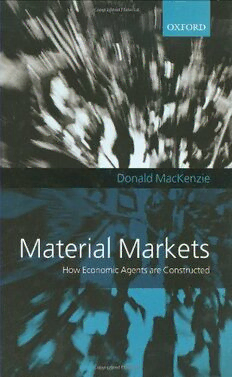
Material Markets: How Economic Agents are Constructed PDF
Preview Material Markets: How Economic Agents are Constructed
The Clarendon Lectures in Management Studies are jointly organized by Oxford University Press and the Saïd Business School. Every year a leading internationalacademicisinvitedtogiveaseriesoflecturesonatopicrelatedto managementeducationandresearch,broadlydefined.Thelecturesformthe basisofabooksubsequentlypublishedbyOxfordUniversityPress. ClarendonLecturesinManagementStudies: TheModernFirm OrganizationalDesignforPerformanceandGrowth JohnRoberts ManagingIntellectualCapital Organizational,Strategic,andPolicyDimensions DavidTeece ThePoliticalDeterminantsofCorporateGovernance PoliticalContext,CorporateImpact MarkRoe TheInternetGalaxy ReflectionsontheInternet,Business,andSociety ManuelCastells BrokerageandClosure AnIntroductiontoSocialCapital RonBurt ReassemblingtheSocial AnIntroductiontoActor-Network-Theory BrunoLatour Gatekeepers TheRoleoftheProfessionsinCorporateGovernance JohnC.Coffee Science,Innovation,andEconomicGrowth(forthcoming) WalterW.Powell TheLogicofPosition,TheMeasureofLeadership PositionandInformationintheMarket(forthcoming) JoelPodolny GlobalCompaniesinthe20thCentury(forthcoming) LeslieHannah Material Markets How Economic Agents Are Constructed Donald MacKenzie 1 3 GreatClarendonStreet,Oxford26 OxfordUniversityPressisadepartmentoftheUniversityofOxford. ItfurtherstheUniversity’sobjectiveofexcellenceinresearch,scholarship, andeducationbypublishingworldwidein Oxford NewYork Auckland CapeTown DaresSalaam HongKong Karachi KualaLumpur Madrid Melbourne MexicoCity Nairobi NewDelhi Shanghai Taipei Toronto Withofficesin Argentina Austria Brazil Chile CzechRepublic France Greece Guatemala Hungary Italy Japan Poland Portugal Singapore SouthKorea Switzerland Thailand Turkey Ukraine Vietnam OxfordisaregisteredtrademarkofOxfordUniversityPress intheUKandincertainothercountries PublishedintheUnitedStates byOxfordUniversityPressInc.,NewYork ©OxfordUniversityPress2009 Themoralrightsoftheauthorhavebeenasserted DatabaserightOxfordUniversityPress(maker) Firstpublished2009 Allrightsreserved.Nopartofthispublicationmaybereproduced, storedinaretrievalsystem,ortransmitted,inanyformorbyanymeans, withoutthepriorpermissioninwritingofOxfordUniversityPress, orasexpresslypermittedbylaw,orundertermsagreedwiththeappropriate reprographicsrightsorganization.Enquiriesconcerningreproduction outsidethescopeoftheaboveshouldbesenttotheRightsDepartment, OxfordUniversityPress,attheaddressabove Youmustnotcirculatethisbookinanyotherbindingorcover andyoumustimposethesameconditiononanyacquirer BritishLibraryCataloguinginPublicationData Dataavailable LibraryofCongressCataloginginPublicationData Dataavailable TypesetbySPIPublisherServices,Pondicherry,India PrintedinGreatBritain onacid-freepaperby BiddlesLtd.,King’sLynn,Norfolk ISBN 978–0–19–927815–2 10 9 8 7 6 5 4 3 2 1 ToBarbara,Moyra,andRobin CONTENTS Acknowledgements viii ListofFigures x 1. Introduction 1 2. TenPreceptsfortheSocialStudiesofFinance 8 3. AssemblinganEconomicActor 37 withIainHardie 4. Derivatives:TheProductionofVirtuality 63 5. TheMaterialSociologyofArbitrage 85 withDanielBeunzaandIainHardie 6. MeasuringProfit 109 7. ConstructingEmissionsMarkets 137 8. Conclusion:OpeningtheBlackBoxesofFinance 177 Glossary 187 Notes 190 References 200 Index 221 ACKNOWLEDGEMENTS I am extremely grateful to the Saïd Business School, University of Oxford, and to Oxford University Press for their invitation to deliver the Clarendon LecturesinManagementStudies,onwhichthisbookisbased.Iwouldalsolike tothanktheUKEconomicandSocialResearchCouncilfortheirawardofa ProfessorialFellowshipon‘SocialStudiesofFinance’(RES-051-27-0062),which madepossibleboththewritingofthisbookandthebulkoftheresearchthat underpins it. My gratitude too to the Institute of Advanced Study, Durham University,foraterm’sfellowshipthathelpedmebringthebooktocomple- tion,andtoInnogen,theESRCCentreforSocialandEconomicResearchon InnovationinGenomics,forsupportingtheunderlyingworkontheconstruc- tionofeconomicagents. Ihavealsoincurredmanymorepersonaldebtsofgratitude:toIainHardie andDanielBeunza(co-authorsofChapters3and5),forallowingmetoreuse our joint work here; to Moyra Forrest, who provided me with copies of the vastmajorityofthepublicationsthatformthisbook’sreferences;toBarbara Silander,whoword-processeditstextandbibliography;andtoRobinWilliams, whohasbeenasteadfastsupporterofmyworkformanyyears.Robinhasalso been a wonderful friend, and Barbara and Moyra deserve special, long-term thanks:theyhavenowworkedwithmeonfivebooks. The input of the many interviewees whose testimony forms the book’s main empirical underpinning was essential. The nature of the book’s sub- jectmatter—and,inmanycases,interviewees’preferences—meanthattheir contributions are generally anonymous. They were vitally important never- theless.IamparticularlygratefultothosewhoallowedmetowatchLIBOR beingcalculatedandtothehedgefundthatpermittedtheobservationsbyIain HardieandmyselfthatformthebasisofChapter3. Threechaptersbuilddirectlyuponarticlespublishedelsewhere:Chapter3 isarevisedversionofHardieandMacKenzie(2007);Chapter4ofMacKenzie (2007a);andChapter5ofBeunza,Hardie,andMacKenzie(2006).Otherwork IhavedrawnonincludesHatherly,Leung,andMacKenzie(forthcoming)and Acknowledgements / ix MacKenzie (2007b; 2008). The Glossary draws upon MacKenzie (2006). I am gratefultothecopyrightholdersforpermissiontomakeuseofthismaterial here. Sections ofChapter 5writtenby Beunza similarlydrawonmaterial in BeunzaandStark(2004). As always, though, I save my most heartfelt thanks of all for my family: Caroline,Alice,andIain. LIST OF FIGURES 2.1. Extensionalsemanticsandfinitism 27 2.2. Whitetoplayandmateinasinglemove 28 3.1. Layoutofthehedge-fundtradingroom 42 4.1. Totalamountsofexchange-tradedderivativesoutstandingatendof Juneofeachyearfrom1998to2006 64 6.1. ExamplesofcodesfromtheUniversityofEdinburgh’schartofaccounts 113 6.2. FrequencydistributionofreportsofnetannualincomebyUS corporations,1976–1994 126 7.1. Thepriceofallowancesforphase1oftheEuropeanUnionEmissions TradingScheme 167 1 Introduction Justafter11.00a.m.,everyweekdaythatisnotabankholiday,anapparently mundane calculation is performed at a couple of desks in an unremarkable open-planofficeinLondon’sDocklands.Smallsetsofnumbersarriveelectron- ically or by telephone. Thetwo peopleorchestrating the calculationcorrect obvious typing mistakes and check less clear-cut discrepancies by telephone calls:‘Hello,it’s[X].Justwanttochecktheone-weekontheDanish[Krone]. Youguysarequoting2.51.Youwanttokeepitaroundthat?’or‘Everyoneelse is coming in a good bit under that.’ Sometimes they telephone and remind those who should have provided figures. Once half the necessary numbers have been input into the computer system that performs the calculation, it begins to process them. On the day I was watching, all the inputs had been received and checked, and the processing completed, by 11.43, and one of the two staff members involved then said to his colleague: ‘You can publish away.’ This undramatic sequence of events produces what is, from the view- point of the amount of money hingeing directly on its outcome, one of the world’s most consequential set of numbers: British Bankers’ Association LIBOR(LondonInterbankOfferedRate),thedominantglobalbenchmarkfor interestrates.OnthedayonwhichIwatchedLIBORbeingset,over$170tril- lionoftheworld’sfinancial‘derivatives’(theequivalentofaround$26,000for everyhumanbeingonearth)wereindexedtoLIBOR,fluctuatinginvalueasit changedfromdaytoday.1Theimportanceofthecalculationisreflectedinthe arrangementsifaterroristincidentorothereventdisruptstheofficeinwhich Iwitnessedit.Anearby,similarlyequippedofficebuildingiskeptinconstant
